Do you have a question about the Coleman 9406A Series and is the answer not in the manual?
Details about the grill's input rating, fuel type, and required regulator.
Explains DANGER, WARNING, and CAUTION symbols used in the manual.
Procedures for detecting and responding to gas leaks.
Safety guidelines regarding flammable liquids and cylinder storage.
Notice regarding carbon monoxide health risks.
Emphasizes outdoor use only, no garages, and no children.
Do not move while lit, keep area clear, avoid hot surfaces, unattended use.
Cylinder disconnection when not in use and outdoor storage requirements.
Installation must comply with local codes and national standards.
Appliance not for installation in or on recreational vehicles or boats.
Minimum clearances and maintaining ventilation flow for safe operation.
LP gas is flammable, heavier than air, and collects in low areas.
Requirements for LP gas cylinders and compatible connections.
Use only the supplied CGA #600 regulator and compatible cylinders.
Never store spare LP cylinders under the grill or near heat sources.
Lists and identifies main parts of the barbecue grill.
Remove packing material and inspect all components before assembly.
Steps for attaching the side table using washers and screws.
Instructions for replacing cooking grates and cooktops.
Steps to fold legs into brackets and secure with bolts.
Inserting and locking the towing handle into the leg.
Attaching the wheels to the grill's axles using bolts and washers.
Releasing leg lockers and extending the grill stand to its upright position.
Locking the grill top into the leg hooks for stability.
Use only marked "Propane" cylinders; installation must be outdoors.
Safety warnings for handling cylinders and storage near heat sources.
Tighten cylinder by hand only; do not use tools.
Verify burner tube is correctly positioned over the orifice fitting.
Check and clean venturi tubes for insect nests or debris.
No smoking or ignition sources, outdoors only, no flame.
Apply soapy solution to connections; bubbles indicate a leak.
Tighten loose joints or replace faulty parts; replace damaged cylinders.
Critical safety steps to observe before using the grill.
Open lid, ensure knobs are off, do not stand over grill.
How to operate the electronic ignition system for lighting.
Step-by-step guide for lighting the burner with a match or lighter.
Prohibits the use of charcoal or lighting fluid for ignition.
Turn both control knobs to the "OFF" position to shut down.
Ensure the disposable cylinder is disconnected when the grill is not in use.
Keep area clean, avoid tipping, ensure ventilation, hot surfaces.
Operate grill for 5 minutes on high to burn off manufacturing oils.
Describes ideal blue flames with yellow tips versus irregular yellow flames.
Guidance on using high, medium, and low flame settings for different foods.
Never leave food unattended, avoid standing directly over the cooking area.
Tips on trimming fat, thawing, seasoning, and turning food for best results.
Shut off gas, let fire burn out, remove cylinder after cooling.
Preheat with lid closed, trim fat, cook fatty meats on low heat.
Heat source directly below food; suitable for searing and quick cooking.
Food cooked away from direct heat; good for tenderizing and preventing burning.
Avoid using items not designed for the grill, like pots on grates.
Do not use grates on campfires or leave empty on burner.
Clean grates with damp cloth or mild detergent after cooking.
Scrape interior with tools, remove excess grease and residue.
Spider webs/nests can obstruct gas flow, causing fire and injury.
Use a flexible brush or wire to remove obstructions from venturi tubes.
Reinstall burner and ensure orifice fittings are inside the venturi tube.
Do not move while lit or hot; clean grease tray; move slowly.
Check gas connections for leaks and venturi alignment after moving.
Clean grill, coat burner, store indoors or cover outdoors.
Checks for fuel, igniter, venturi blockages, and regulator issues.
Addresses venturi alignment, new burner oil, and burner cleaning.
Solutions for excessive heat, flame blowouts, and windy conditions.
Immediate actions for fires, checking connections, and leaks.
Lists and illustrates replaceable parts and optional accessories.
Details what the warranty covers and what it does not cover.
Instructions on how to contact Coleman for warranty service and return procedures.
Details about the grill's input rating, fuel type, and required regulator.
Explains DANGER, WARNING, and CAUTION symbols used in the manual.
Procedures for detecting and responding to gas leaks.
Safety guidelines regarding flammable liquids and cylinder storage.
Notice regarding carbon monoxide health risks.
Emphasizes outdoor use only, no garages, and no children.
Do not move while lit, keep area clear, avoid hot surfaces, unattended use.
Cylinder disconnection when not in use and outdoor storage requirements.
Installation must comply with local codes and national standards.
Appliance not for installation in or on recreational vehicles or boats.
Minimum clearances and maintaining ventilation flow for safe operation.
LP gas is flammable, heavier than air, and collects in low areas.
Requirements for LP gas cylinders and compatible connections.
Use only the supplied CGA #600 regulator and compatible cylinders.
Never store spare LP cylinders under the grill or near heat sources.
Lists and identifies main parts of the barbecue grill.
Remove packing material and inspect all components before assembly.
Steps for attaching the side table using washers and screws.
Instructions for replacing cooking grates and cooktops.
Steps to fold legs into brackets and secure with bolts.
Inserting and locking the towing handle into the leg.
Attaching the wheels to the grill's axles using bolts and washers.
Releasing leg lockers and extending the grill stand to its upright position.
Locking the grill top into the leg hooks for stability.
Use only marked "Propane" cylinders; installation must be outdoors.
Safety warnings for handling cylinders and storage near heat sources.
Tighten cylinder by hand only; do not use tools.
Verify burner tube is correctly positioned over the orifice fitting.
Check and clean venturi tubes for insect nests or debris.
No smoking or ignition sources, outdoors only, no flame.
Apply soapy solution to connections; bubbles indicate a leak.
Tighten loose joints or replace faulty parts; replace damaged cylinders.
Critical safety steps to observe before using the grill.
Open lid, ensure knobs are off, do not stand over grill.
How to operate the electronic ignition system for lighting.
Step-by-step guide for lighting the burner with a match or lighter.
Prohibits the use of charcoal or lighting fluid for ignition.
Turn both control knobs to the "OFF" position to shut down.
Ensure the disposable cylinder is disconnected when the grill is not in use.
Keep area clean, avoid tipping, ensure ventilation, hot surfaces.
Operate grill for 5 minutes on high to burn off manufacturing oils.
Describes ideal blue flames with yellow tips versus irregular yellow flames.
Guidance on using high, medium, and low flame settings for different foods.
Never leave food unattended, avoid standing directly over the cooking area.
Tips on trimming fat, thawing, seasoning, and turning food for best results.
Shut off gas, let fire burn out, remove cylinder after cooling.
Preheat with lid closed, trim fat, cook fatty meats on low heat.
Heat source directly below food; suitable for searing and quick cooking.
Food cooked away from direct heat; good for tenderizing and preventing burning.
Avoid using items not designed for the grill, like pots on grates.
Do not use grates on campfires or leave empty on burner.
Clean grates with damp cloth or mild detergent after cooking.
Scrape interior with tools, remove excess grease and residue.
Spider webs/nests can obstruct gas flow, causing fire and injury.
Use a flexible brush or wire to remove obstructions from venturi tubes.
Reinstall burner and ensure orifice fittings are inside the venturi tube.
Do not move while lit or hot; clean grease tray; move slowly.
Check gas connections for leaks and venturi alignment after moving.
Clean grill, coat burner, store indoors or cover outdoors.
Checks for fuel, igniter, venturi blockages, and regulator issues.
Addresses venturi alignment, new burner oil, and burner cleaning.
Solutions for excessive heat, flame blowouts, and windy conditions.
Immediate actions for fires, checking connections, and leaks.
Lists and illustrates replaceable parts and optional accessories.
Details what the warranty covers and what it does not cover.
Instructions on how to contact Coleman for warranty service and return procedures.
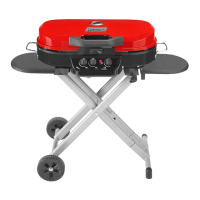


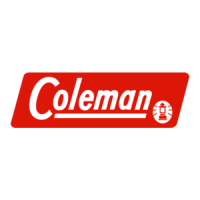
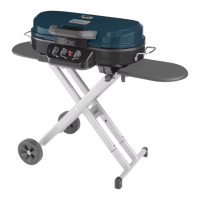
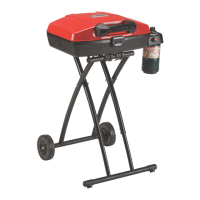
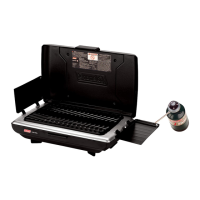
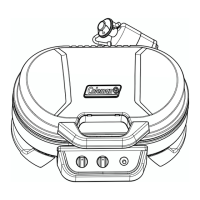

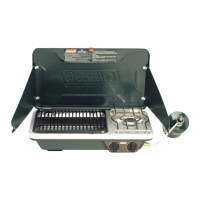
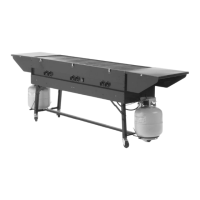
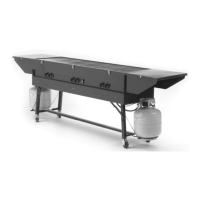
